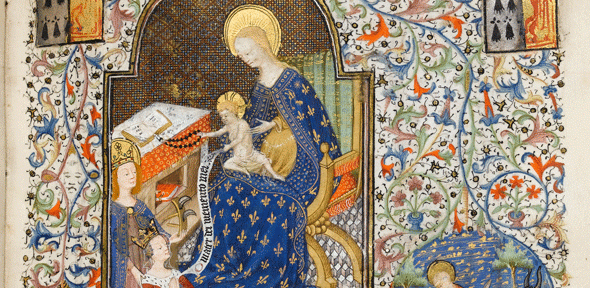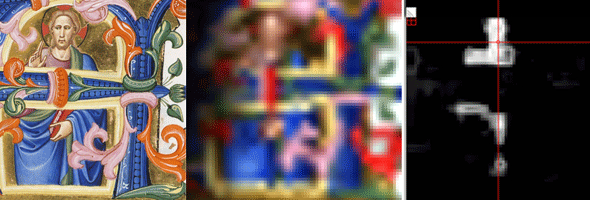Hours of Isabella Stuart - Wikipedia, the free encyclopedia
en.wikipedia.org/wiki/Hours_of_Isabella_Stuart
The Hours of Isabella Stuart, Duchess of Brittany are an illuminated Book of Hours produced at Angers around 1417/18 (or 1431?) in the workshop of the Rohan ...
Illuminating art’s history

Scientific imaging techniques are uncovering secrets locked in medieval illuminated manuscripts – including those of a thrifty duke.
Identifying the ways in which they used the same materials in different media, or transferred materials and techniques across media, offers a whole new way of looking at artStella Panayotova
Faced with the prospect of his rapidly approaching nuptials on 29 October 1442, and with no wedding gift purchased for his bride-to-be, Francis I of Brittany (1414–1450) did what many of us have done at some point: he ‘re-gifted’. He took something that was already in his possession and gave it to someone else.
But this was no ordinary gift: it was an illuminated manuscript, made for Francis’ first wife, Yolande of Anjou, who had died in 1440. Francis had it altered and presented it to his new bride, Isabella Stuart, daughter of James I. The portrait of his first wife was covered with that of Isabella and an image of St Catherine was added, using cheaper pigments. Then, when Francis was made a duke, the portrait was painted over yet again to give Isabella a coronet.
Art historians have written volumes on the Hours of Isabella Stuart over the last century, but a cross-disciplinary Cambridge project is using a variety of imaging techniques to uncover this story of re-gifting. The team’s work is challenging previous assumptions about this and many other manuscripts, helping them to see and understand medieval painting and illumination in new and unexpected ways.
Combining research in the arts, humanities, sciences and technology, MINIARE (Manuscript Illumination: Non-Invasive Analysis, Research and Expertise) currently focuses on uncovering the secrets of medieval art, but it is anticipated that many of the imaging techniques they are adapting may be used to study other types of art, from a range of different periods.
The project is led by Dr Stella Panayotova, Keeper of Manuscripts and Printed Books at the Fitzwilliam Museum, and Professor Stephen Elliott of the Department of Chemistry, who are working with colleagues from across the University and around the world.
“Working in a truly cross-disciplinary way can benefit art history, scientific research and visual culture in general, while pushing technology forward at the same time,” said Panayotova. “Thanks to the imaging techniques we’ve been using, we can see things in these manuscripts that we couldn’t see before.”

Much of what we know about illuminated manuscripts comes from art-historical analysis and circumstantial evidence. Since they are so delicate and the layers of pigment are so thin, manuscripts are seriously compromised by taking samples, which is common practice for the analysis of panel or fresco paintings. To gather hard evidence about how these manuscripts were made, while preserving them, non-invasive techniques are required.
“For our team, it was about finding new applications for existing techniques, and pushing them far beyond current boundaries in order to analyse the very thin layers of a manuscript,” said Elliott. “Part of our research is in the area of medical diagnostics and environmental sensing, where we analyse materials in very thin layers, which is not so different from analysing a painting. So we could certainly see what the problems were.”
Using a combination of imaging techniques, including photomicroscopy, visible and infrared imaging at multiple wavelengths, reflectance imaging spectroscopy and optical coherence tomography, the MINIARE team is able to peer through the layers of a painting to uncover its history, as in the case of the Hours of Isabella Stuart.
“We do have to adapt conventional analytical techniques to make them safe to use on something as fragile as an illuminated manuscript,” said conservation scientist Dr Paola Ricciardi. “For instance, Raman spectroscopy is a brilliant technique, but it’s a challenge to use it on a manuscript as we tend to use one-hundredth of the laser power that we would on a less fragile object.”
The technological challenge for the MINIARE team is making sure the imaging technology is non-invasive enough to keep the manuscript safe, but still sensitive enough to get an accurate result. Many of the imaging tools that the team use are in fact not cameras, but scanners that acquire a spectrum at each point as they scan an entire object. The resulting ‘spectral image cubes’ can then provide information about the types of materials that were used, as well as the ability to see different layers present in the manuscript.
Combining these non-invasive imaging techniques not only helps the researchers to distinguish between artists by analysing which materials they used and how they employed them, but also helps them to learn more about the technical know-how that these artists possessed.
“Many of the artists we’re looking at didn’t just work on manuscripts,” said Panayotova. “Some of them were panel painters or fresco painters, while others also worked in glass, textiles or metal. Identifying the ways in which they used the same materials in different media, or transferred materials and techniques across media, offers a whole new way of looking at art.”
For example, Ricciardi has found evidence for the use of smalt, a finely ground blue glass, as a pigment in an early 15th-century Venetian manuscript made in Murano. The use of a glass-based pigment is not unexpected given the proximity of the Murano glass factories, but this illuminator was working half a century before any other Venetian easel painter whose works are known to contain smalt.

Another unexpected material that the MINIARE team has encountered is egg yolk, which was a common paint binder for panel paintings, but not recommended for manuscript illumination – instead, egg white or gum were normally used. By making a hyperspectral reflectance map of the manuscript, the researchers were able to gather information about the pigments and binders, and determine that some manuscript painters were most likely working across a variety of media.
The techniques that the team are developing and refining for manuscripts will also see application in other types of art. “All of the imaging techniques we’re using on the small scale of medieval manuscripts need to be scalable, in order that we can apply them to easel paintings and many other types of art,” said Dr Spike Bucklow of the Hamilton Kerr Institute. “It’s an opportunity to see how disciplines relate to each other.”
MINIARE (www.miniare.org) involves the Fitzwilliam Museum, Hamilton Kerr Institute, Departments of Chemistry, Physics, History of Art, History and Philosophy of Science, and Applied Mathematics and Theoretical Physics, as well as the Victoria & Albert Museum, Durham University, Nottingham Trent University, Antwerp University, Getty Conservation Institute, J Paul Getty Museum, National Gallery of Art in Washington DC and SmartDrive Ltd.
Inset image – top: Macroscopic X-ray fluorescence imaging has allowed to prove the presence of smalt, a cobalt-containing glass pigment, mixed with ultramarine blue in selected areas of this early 15th century manuscript fragment painted by the Master of the Murano gradual; Left: Fitzwilliam Museum, Marlay Cutting It 18; Right: Cobalt distribution map; Credit: S. Legrand and K. Janssens, Department of Chemistry, University of Antwerp.
Inset image – bottom: Hyperspectral reflectance imaging in the visible and near-infrared range confirms evidence for the use of egg yolk as a paint binder only in figurative areas within the decorated initials in the Missal of Cardinal Angelo Acciaiuoli, painted in Florence ca. 1404; Left: Fitzwilliam Museum, MS 30, fol 1r (detail); Centre: RGB composite obtained from the hyperspectral image cube; Right: egg yolk distribution map, showing its use to paint the figure of Christ with the exclusion of his ultramarine blue robe; Credit: J. K. Delaney and K. Dooley, National Gallery of Art, Washington DC.
The text in this work is licensed under a Creative Commons Licence. If you use this content on your site please link back to this page. For image rights, please see the credits associated with each individual image.
- See more at: http://www.cam.ac.uk/research/features/illuminating-arts-history#sthash.d2lqodCM.ELLEabIk.dpuf
沒有留言:
張貼留言